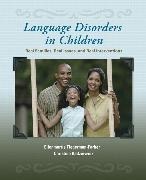Read more
List of contents
PART I Birth to Age 3: A Family-Centered Approach
Chapter 1-Understanding Early Intervention for Infants and Toddlers
Chapter 2-Language Disorders in Infants and Toddlers
Chapter 3-Collaborative Language Assessment and Decision Making for Infants and Toddlers
Chapter 4-Language Interventions for Infants and Toddlers
PART II Preschool: A Child-Centered Approach
Chapter 5-Understanding Early Childhood Education
Chapter 6-Language Differences in Preschool
Chapter 7-Cultural and Linguistic Diversity
Chapter 8-Collaborative Language Assessment and Decision Making in Preschool
Chapter 9-Language Interventions and Professional Collaboration in Preschool
PART III The Elementary School: A Collaborative Approach
Chapter 10-Understanding Elementary Schools
Chapter 11-Language Disorders in Elementary School
Chapter 12-Collaboratove Language Assessment and Decision Making in Elementary School
Chapter 13-Language Intervention Strategies for 5 to 8-Year-Olds
Summary
The goal of this text is to show how the role of the speech-language pathologist has changed; what clinical intervention techniques are successfully being used today with children with different developmental disabilities; and what policies and procedures affect clinical practice. Language Disorders in Children introduces three families whose stories exemplify the challenges faced by families whose children have disabilities. Three developmental disabilities--autism, speech-language impairment, and hearing loss--are chosen as examples to highlight present-day language theories and clinical practices.

